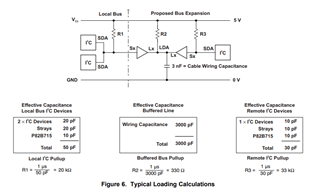Hi Experts,
Seeking your assistance on this query from Cx about P82B715 bus expander.
For this I have built a network (see schematic2.png), which unfortunately cannot be simplified further. A microcontroller sits with the first P82B715 in a distribution. The I/O expander, sensor 1, sensor 2, sensor 3, sensor 4, sensor 5 are connected star-shaped with the first expander. The meter value 7 m e.g. stands for the distance from the first expander to the expander of sensor 1.
The expanders of sensor 6 and sensor 7 are connected in parallel to the expander of sensor 5 and have no direct connection to the first expander.
Each of the .1 sensors are always connected in parallel to the main expander from the sensor with a cable length of 0.3m.
The used cable type is Cat 7 and all components are powered with 5V.
In the datasheet there is a chapter for the calculation of the pullup resistors. Unfortunately I didn't understand it yet.
In the schematic I have drawn all possible pullup resistors.
[1] First the general question, can I build the network like this?
[2] Which resistors do I really need?
[3] And how big do the resistors have to be?
I would be very grateful if device expert could get some information about this.
Regards,
Archie A.




